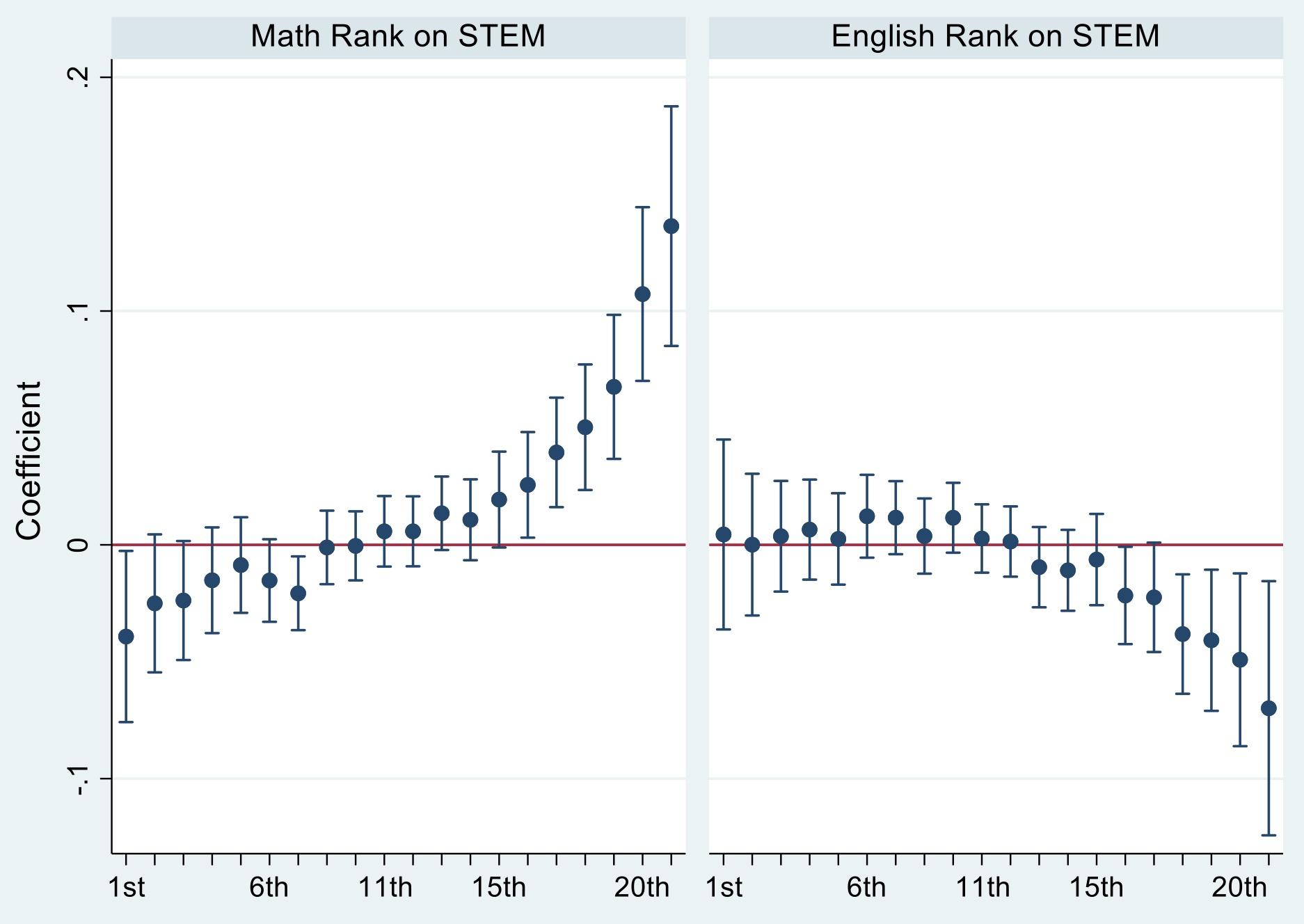There are many contemporary policy-related debates in education, such as whether high-ability peers affect student achievement and how to encourage more female students to choose STEM programmes in college and university. Interestingly, how we think about these issues may be determined by whether students are influenced by their academic rank relative to other children in their class or year group. When studying academic rank, researchers typically evaluate students based on their performance in aptitude or achievement tests with the goal of determining whether – holding all else equal, including absolute levels of ability or performance – having a higher rank leads to better subsequent student outcomes.
The effect of academic rank is a particular type of peer effect that depends on both the student’s own level of human capital and the level of their peers. The empirical challenge is to distinguish the effect of rank from other possible peer and classroom effects while allowing for correlations of rank with absolute achievement and with student characteristics such as gender or race.
Important papers such as Murphy and Weinhardt (2020), Cicalo et al. (2018), and Elsner and Isphording (2017, 2018) recently kickstarted a large literature on rank effects; we have learned much about the size of these effects and their relevance to understanding broader issues in the economics of education. Our recent survey paper (Devereux and Delaney 2022) reviews this recent literature, describing the difficult identification and measurement issues, the assumptions and methodologies underpinning the literature, and the empirical results. In this column, we describe why rank matters and outline some of the main findings, but we focus on what insights the existence of rank effects provide into other educational phenomena, such as the extent to which students benefit from high-ability peers and the presence of a gender gap in STEM.
Why might academic rank matter?
Student rank can affect later outcomes through many different channels. Having a higher rank may increase confidence and lead students to study more and do better, to hang out with and be influenced by other higher-ranked students, or to be less likely to engage in disruptive behaviour. Also, teachers and parents may provide more support and encouragement to higher-ranked students and this may lead to better performance. Likewise, a higher rank in a subject may cause a student to believe that their comparative advantage is in that area and to subsequently choose it as a specialisation in college or university. Rank effects can even be somewhat mechanical if universities are more likely to admit students who have a higher rank in secondary school. While there are many potential mechanisms, evidence suggests that being ranked higher increases student confidence in their ability, leading to beneficial effects on their behaviour and expectations.
Major findings about rank
Research that accounts for ability or achievement across a range of countries, ages, and types of educational institutions has typically found that students who are more highly ranked in their class or grade have better subsequent outcomes. For example, using UK data, Murphy and Weinhardt (2020) find that students who are higher ranked in primary school achieve higher test scores during secondary school. In the US, Elsner and Isphording (2017, 2018) find that students with a higher rank are more likely to complete secondary school and attend university, and they find that rank has a negative effect on the likelihood of smoking, drinking, having unprotected sex, and engaging in violence. The sizes of effect by rank are generally large when compared to magnitudes found for other factors and interventions. For example, using US data, Denning et al. (2021) find that moving from the 25th to the 75th percentile of third grade (year four) rank increases earnings at ages 23–27 by about 7%, which is a typical estimate of the earnings return to an extra year of schooling.
Implications for effects of peer groups
If students benefit from having a higher rank, it may offset or negate any benefits of having high-performing peers, as having more high-ability peers will tend to reduce their class rank. Therefore, rank effects can rationalise the common failure to find strong positive effects of high-ability peers when account is not taken of rank in estimation (Cools et al. 2019). Indeed, Bertoni and Nistico (2019) demonstrate that the estimated effect of high-ability peers is much more positive when regression controls are introduced for rank. As such, findings from the literature about rank have important implications for how we think about peer effects in general.
Implications for gender gaps in STEM
Women are still greatly underrepresented in science, technology, engineering, and mathematics (STEM) programmes at university (Kugler et al. 2017, Delaney and Devereux 2019), and choices of field can have important implications for future labour market success (Dahl et al. 2020). Research has linked this gender gap to many factors, including the comparative advantage of girls in verbal skills rather than mathematics. However, students may not know their subject-specific ability and may infer comparative advantage across subjects from their rank in these subjects in their school or class. At any given absolute level of mathematical and verbal ability, this may lead students with a high rank in mathematics relative to verbal skills to be more likely to apply to university STEM programs.
In Delaney and Devereux (2021), we use Irish administrative data on university applicants to investigate whether, conditional on absolute achievement at the end of secondary school, within-grade rank in English and mathematics affects choice of a university major. We find that a higher rank in mathematics increases the likelihood of applying to a university STEM programme, while a higher rank in English decreases the probability. Figure 1 illustrates this finding using a flexible specification that includes indicator variables for being in each ventile of the rank distribution plus indicators for being the top person(s) in the subject in the school-cohort, with the 10th ventile being the omitted category. The regression controls for test scores in mathematics and English as well as many other school- and cohort-level variables. The coefficient estimates and 95% confidence intervals are plotted. The effect of math rank on STEM is approximately linear with students who have a higher rank in mathematics being more likely to apply to a STEM field. In contrast, the negative effect of English rank on STEM is only obvious in the top half of the English rank distribution; the relationship is quite flat in the bottom half of the distribution.
Figure 1 Effect of rank ventiles and top-ranked person in math and English on first preference field of study
Notes: Estimates from regressions where subject rank is entered in ventiles, with an additional category for the top ranked person(s). The omitted category is the 10th ventile. Point estimates and 95% confidence intervals are shown.
Source: Delaney and Devereux (2021).
In mixed-sex schools, males tend to average a higher rank in mathematics and a lower rank in English than do female students (Delaney and Devereux 2021). We estimate that the gender gap in preferences for STEM at university would be reduced by about 4% in mixed-sex schools if boys and girls had the same ranks in both subjects, while holding their absolute levels of academic achievement constant. Rank effects can also partly explain why there is a greater gender gap in STEM university applications in Irish mixed-sex schools compared to same-sex schools: in same-sex schools, the average rank of boys and girls is, by definition, the same in each subject. Overall, differing ranks in mathematics and English can explain a small but meaningful share of the gender gap in the decision to choose STEM as a college or university major.
Concluding remarks
The evidence for sizeable long-term effects of academic rank raises questions about how well students know their rank and whether they should be provided further information. Students may use their class rank in a subject as a measure of how able they are at that subject, which may lead to suboptimal career choices if they are in a school or class that is atypical in terms of the distribution of student abilities. If students are influenced by their rank, it may be helpful to provide them with information about their ability or achievement in various subjects relative to the general population. Given evidence that class rank is influential but sometimes misleading, this policy intervention could empower students to make better decisions about their university major and perhaps about other educational and career choices as well.
References
Bertoni, M and R Nisticò (2019), “Ordinal rank and peer composition: Two sides of the same coin?”, IZA Discussion Paper No. 12789.
Cicala, S, R G Fryer and J L Spenkuch (2018), “Self-Selection and comparative advantage in social interactions”, Journal of the European Economic Association 16(4): 983–1020.
Cools, A, R Fernández, and E Patacchini (2019), “Girls, boys, and high achievers”, VoxEU.org, 30 August.
Dahl, G, D Rooth and A Stenberg (2020), “Earnings payoffs to different fields of study in secondary school”, VoxEU.org, 10 November.
Delaney, J M and P J Devereux (2019), “It’s not just for boys! Understanding gender differences in STEM”, VoxEU.org, 19 April.
Delaney, J M and P J Devereux (2021), “High school rank in math and English and the gender gap in STEM”, Labour Economics 69.
Delaney, J M and P J Devereux (2022), “Rank effects in education: What do we know so far?”, CEPR Discussion Paper 17090.
Denning, J T, R Murphy and F Weinhardt (2021), “Class rank and long-run outcomes”, NBER Working Paper 27468.
Elsner, B and I E Isphording (2017), “A big fish in a small pond: Ability rank and human capital Investment”, Journal of Labor Economics 35(3): 787–828.
Elsner, B and I E Isphording (2018), “Rank, sex, drugs and crime”, Journal of Human Resources 53(2): 356–381.
Kugler, A, C Tinsley and O Ukhaneva (2017), “Why there aren't more women in STEM fields”, VoxEU.org, 2 November.
Murphy, R and F Weinhardt (2020), “Top of the class: The importance of ordinal rank”, Review of Economic Studies 87(6): 2777–2826.




